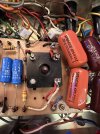Hi folks,
I have an old 72 plexi that was fortunate enough to Inherit. At first it made no sound. I've built a bunch of amps years ago and took a look and checked some voltages. I noticed that one of the one of the 1k/5W resistors attached to pin4 of one of the output sockets had a broken lead so I replaced it. On it went and it sounds amazing
It's been modded for more gain many years ago it seeks with a master volume, some additional bypass caps in the preamp and some additional caps in the power section but most of the meat of the signal chain seems original (caps, resistors, solder joints).
Again, it sounds bad ass....BUT, I decided to check the bias as one would and it seems insanely high. I used my old Weber BiasRite checker and I got 388 volts-ish on the plates (they were not matched and are the original Tesla Tubes so that may have something to do with it or some out of range resistor... Also I know this seems quite low but I thought it may have something to do with the mods and running on lower voltages as a kind of fake Variac???
Either way, the Cathode current on the meter read 95!! From the bias equation I believe they should be around 45..
Again, it sounds incredible, but I fear that it may only sound that way for 3 minutes before it blows something...
I know a bit about amps and have built my own plexi and a few other amps but I don't know that much. Wondering if anyone has any ideas. It could be the bias resistor needs to be replaced, or maybe the tubes (or both).
Also, This is the lowest I could get the reading on the bias pot!
Am I reading something wrong?
Thank you for any help or insight!
-Matt
I have an old 72 plexi that was fortunate enough to Inherit. At first it made no sound. I've built a bunch of amps years ago and took a look and checked some voltages. I noticed that one of the one of the 1k/5W resistors attached to pin4 of one of the output sockets had a broken lead so I replaced it. On it went and it sounds amazing

It's been modded for more gain many years ago it seeks with a master volume, some additional bypass caps in the preamp and some additional caps in the power section but most of the meat of the signal chain seems original (caps, resistors, solder joints).
Again, it sounds bad ass....BUT, I decided to check the bias as one would and it seems insanely high. I used my old Weber BiasRite checker and I got 388 volts-ish on the plates (they were not matched and are the original Tesla Tubes so that may have something to do with it or some out of range resistor... Also I know this seems quite low but I thought it may have something to do with the mods and running on lower voltages as a kind of fake Variac???
Either way, the Cathode current on the meter read 95!! From the bias equation I believe they should be around 45..
Again, it sounds incredible, but I fear that it may only sound that way for 3 minutes before it blows something...
I know a bit about amps and have built my own plexi and a few other amps but I don't know that much. Wondering if anyone has any ideas. It could be the bias resistor needs to be replaced, or maybe the tubes (or both).
Also, This is the lowest I could get the reading on the bias pot!
Am I reading something wrong?
Thank you for any help or insight!
-Matt




